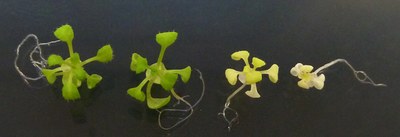Posttranslational control of glutamyl-tRNA Reductase
Janina Apitz, Judith Schmied, Zhiwei Hou, Boris Hedtke
Plant tetrapyrrole metabolism is introduced with the initial 5-aminolevulinic acid (ALA) synthesis, which is the rate-determining step for the synthesis of chlorophyll and heme. The first reaction exclusively dedicated to the generation of tetrapyrrole compounds uses activated glutamate (glutamyl-tRNAglu) and is executed by glutamyl-tRNA reductase (GluTR). In plants, this enzyme is found in two isoforms, GluTR1 and GluTR2, respectively. The HEMA1 gene encoding GluTR1 is responsible for main GluTR activity in photoautotrophic tissue and is known to be regulated by light, plant hormones and the circadian clock. HEMA2 is more constantly, but to a lesser extent expressed in all plant tissues and induced by stress. GluTR converts its substrate to glutamate-1-semialdehyde (GSA), which is further processed by a GSA aminotransferase (GSAT) to yield ALA. The GluTR structure consists of an N-terminal putative heme-binding domain (HBD) of approximately 30 amino acid residues, followed by the central catalytic and NADPH-binding domains and at the C-terminal end the dimerization domain and a FLU-binding domain.
Our work on the regulation of ALA synthesis recently focused on the posttranslational control of GluTR in tobacco as well as in Arabidopsis. The results hinted at multiple interactions with regulatory components as well as with enzymes of the tetrapyrrole pathway to control the abundance and activity of GluTR.

Arabidopsis seedlings from left to right: Wild-type (Col-0), hema2, hema1, hema1/hema1/hema2/HEMA2.
While a complete loss of GluTR2 (hema2 mutant) does not result in a visible phenotype, the knockout mutant for GluTR1 (hema1) is unable to grow photoautotrophically. Here, a further reduction of GluTR2 amounts as observed in plants which are hemizygous for hema2 in hema1 mutant background intensifies the hema1 phenotype (right side). Plants were grown for 28 days on sucrose-containing MS medium.